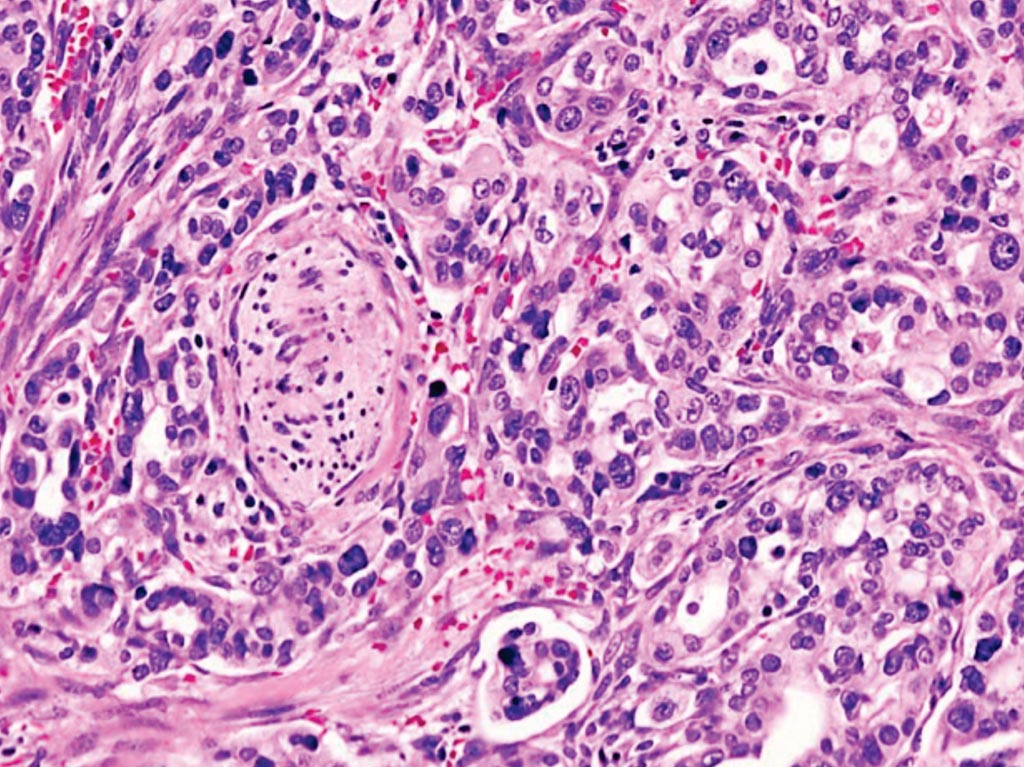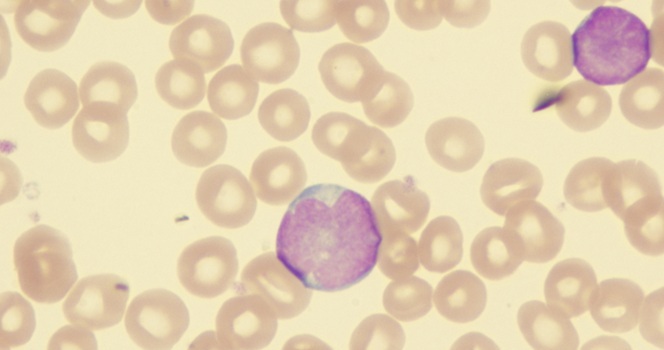Pancreatic Cancer Risk Rises with Fasting Glucose
|
By LabMedica International staff writers Posted on 15 Aug 2019 |

Image: A histopathology of pancreatic ductal adenocarcinoma, the most common type of pancreatic cancer, arising in the pancreas head region (Photo courtesy of KGH).
More than 56,000 Americans are expected to be diagnosed with pancreatic cancer in 2019, which is more than 150 people diagnosed every day. Pancreatic cancer is the ninth most commonly diagnosed cancer in women and the 10th most commonly diagnosed in men in the USA.
The pancreas is a gland located deep in the abdomen, between the stomach and the spine. It makes enzymes that help digestion and hormones that control blood-sugar levels. Pancreatic cancer’s exact causes are not well understood. About 5% to 10% of pancreatic cancers are considered familial or hereditary. Most pancreatic cancer happens randomly or is caused by things such as smoking, obesity and age.
A team of scientists associated with Kangbuk Samsung Hospital (Seoul, Korea) analyzed data from 25.4 million patients who participated in a health examination between 2009 and 2013, using data from the National Health Insurance Service. They evaluated pancreatic cancer incidence rates according to fasting glucose level. Cumulative incidence rate for pancreatic cancer was calculated after grouping patients according to low-normal (< 90 mg/dL), high-normal (90-99 mg/dL), prediabetes level 1 (100-109 mg/dL), prediabetes level 2 (110-125 mg/dL), type 2 diabetes (≥126 mg/dL) and type 2 diabetes on anti-diabetic medications.
The investigators identified 11,429 new cases of pancreatic cancer. They found that the risk for pancreatic cancer increased continuously with elevating fasting glucose levels. The 5-year cumulative incidence rates (per 100,000) were 32 for low-normal, 41 for high-normal, 50 for prediabetes level 1, 64 for prediabetes level 2, 75 for type 2 diabetes and 121 for patients prescribed anti-diabetes medications. The incidence of pancreatic cancer increased significantly with increasing fasting blood glucose levels even after adjusting for age, sex, smoking, drinking, exercise, body mass index and diabetes duration.
In analyses investigating the relationship between the diabetes duration and pancreatic cancer, the team observed a J-shaped association. There was no significant difference in the incidence of pancreatic cancer between the patients who received insulin and those who did not among populations treated with anti-diabetic medications.
Cheol-Young Park, MD, PhD, an Endocrinologist and senior author of the study, said, “Diabetes is one of the established risk factors for pancreatic cancer. When we evaluated the pancreatic cancer incidence according to fasting glucose levels using a national cohort database, we found the number of pancreatic cancer cases rose as fasting glucose levels increased. This was true in people who had diabetes as well as those who did not.” The study was published on July 24, 2019, in The Journal of Clinical Endocrinology & Metabolism.
Related Links:
Kangbuk Samsung Hospital
The pancreas is a gland located deep in the abdomen, between the stomach and the spine. It makes enzymes that help digestion and hormones that control blood-sugar levels. Pancreatic cancer’s exact causes are not well understood. About 5% to 10% of pancreatic cancers are considered familial or hereditary. Most pancreatic cancer happens randomly or is caused by things such as smoking, obesity and age.
A team of scientists associated with Kangbuk Samsung Hospital (Seoul, Korea) analyzed data from 25.4 million patients who participated in a health examination between 2009 and 2013, using data from the National Health Insurance Service. They evaluated pancreatic cancer incidence rates according to fasting glucose level. Cumulative incidence rate for pancreatic cancer was calculated after grouping patients according to low-normal (< 90 mg/dL), high-normal (90-99 mg/dL), prediabetes level 1 (100-109 mg/dL), prediabetes level 2 (110-125 mg/dL), type 2 diabetes (≥126 mg/dL) and type 2 diabetes on anti-diabetic medications.
The investigators identified 11,429 new cases of pancreatic cancer. They found that the risk for pancreatic cancer increased continuously with elevating fasting glucose levels. The 5-year cumulative incidence rates (per 100,000) were 32 for low-normal, 41 for high-normal, 50 for prediabetes level 1, 64 for prediabetes level 2, 75 for type 2 diabetes and 121 for patients prescribed anti-diabetes medications. The incidence of pancreatic cancer increased significantly with increasing fasting blood glucose levels even after adjusting for age, sex, smoking, drinking, exercise, body mass index and diabetes duration.
In analyses investigating the relationship between the diabetes duration and pancreatic cancer, the team observed a J-shaped association. There was no significant difference in the incidence of pancreatic cancer between the patients who received insulin and those who did not among populations treated with anti-diabetic medications.
Cheol-Young Park, MD, PhD, an Endocrinologist and senior author of the study, said, “Diabetes is one of the established risk factors for pancreatic cancer. When we evaluated the pancreatic cancer incidence according to fasting glucose levels using a national cohort database, we found the number of pancreatic cancer cases rose as fasting glucose levels increased. This was true in people who had diabetes as well as those who did not.” The study was published on July 24, 2019, in The Journal of Clinical Endocrinology & Metabolism.
Related Links:
Kangbuk Samsung Hospital
Latest Clinical Chem. News
- Chemical Imaging Probe Could Track and Treat Prostate Cancer
- Mismatch Between Two Common Kidney Function Tests Indicates Serious Health Problems
- VOCs Show Promise for Early Multi-Cancer Detection
- Portable Raman Spectroscopy Offers Cost-Effective Kidney Disease Diagnosis at POC
- Gold Nanoparticles to Improve Accuracy of Ovarian Cancer Diagnosis
- Simultaneous Cell Isolation Technology Improves Cancer Diagnostic Accuracy
- Simple Non-Invasive Hair-Based Test Could Speed ALS Diagnosis
- Paper Strip Saliva Test Detects Elevated Uric Acid Levels Without Blood Draws
- Prostate Cancer Markers Based on Chemical Make-Up of Calcifications to Speed Up Detection
- Breath Test Could Help Detect Blood Cancers
- ML-Powered Gas Sensors to Detect Pathogens and AMR at POC
- Saliva-Based Cancer Detection Technology Eliminates Need for Complex Sample Preparation
- Skin Swabs Could Detect Parkinson’s Years Before Symptoms Appear
- New Clinical Chemistry Analyzer Designed to Meet Growing Demands of Modern Labs

- New Reference Measurement Procedure Standardizes Nucleic Acid Amplification Test Results
- Pen-Like Tool Quickly and Non-Invasively Detects Opioids from Skin
Channels
Molecular Diagnostics
view channel
Simple Urine Test to Revolutionize Bladder Cancer Diagnosis and Treatment
Bladder cancer is one of the most common and deadly urological cancers and is marked by a high rate of recurrence. Diagnosis and follow-up still rely heavily on invasive cystoscopy or urine cytology, which... Read more
Blood Test to Enable Earlier and Simpler Detection of Liver Fibrosis
Persistent liver damage caused by alcohol misuse or viral infections can trigger liver fibrosis, a condition in which healthy tissue is gradually replaced by collagen fibers. Even after successful treatment... Read moreHematology
view channel
Platelet Activity Blood Test in Middle Age Could Identify Early Alzheimer’s Risk
Early detection of Alzheimer’s disease remains one of the biggest unmet needs in neurology, particularly because the biological changes underlying the disorder begin decades before memory symptoms appear.... Read more
Microvesicles Measurement Could Detect Vascular Injury in Sickle Cell Disease Patients
Assessing disease severity in sickle cell disease (SCD) remains challenging, especially when trying to predict hemolysis, vascular injury, and risk of complications such as vaso-occlusive crises.... Read more
ADLM’s New Coagulation Testing Guidance to Improve Care for Patients on Blood Thinners
Direct oral anticoagulants (DOACs) are one of the most common types of blood thinners. Patients take them to prevent a host of complications that could arise from blood clotting, including stroke, deep... Read moreImmunology
view channel
New Test Distinguishes Vaccine-Induced False Positives from Active HIV Infection
Since HIV was identified in 1983, more than 91 million people have contracted the virus, and over 44 million have died from related causes. Today, nearly 40 million individuals worldwide live with HIV-1,... Read more
Gene Signature Test Predicts Response to Key Breast Cancer Treatment
DK4/6 inhibitors paired with hormone therapy have become a cornerstone treatment for advanced HR+/HER2– breast cancer, slowing tumor growth by blocking key proteins that drive cell division.... Read more
Chip Captures Cancer Cells from Blood to Help Select Right Breast Cancer Treatment
Ductal carcinoma in situ (DCIS) accounts for about a quarter of all breast cancer cases and generally carries a good prognosis. This non-invasive form of the disease may or may not become life-threatening.... Read moreMicrobiology
view channel
Rapid Diagnostic Test Matches Gold Standard for Sepsis Detection
Sepsis kills 11 million people worldwide every year and generates massive healthcare costs. In the USA and Europe alone, sepsis accounts for USD 100 billion in annual hospitalization expenses.... Read moreRapid POC Tuberculosis Test Provides Results Within 15 Minutes
Tuberculosis remains one of the world’s deadliest infectious diseases, and reducing new cases depends on identifying individuals with latent infection before it progresses. Current diagnostic tools often... Read more
Rapid Assay Identifies Bloodstream Infection Pathogens Directly from Patient Samples
Bloodstream infections in sepsis progress quickly and demand rapid, precise diagnosis. Current blood-culture methods often take one to five days to identify the pathogen, leaving clinicians to treat blindly... Read morePathology
view channel
Tunable Cell-Sorting Device Holds Potential for Multiple Biomedical Applications
Isolating rare cancer cells from blood is essential for diagnosing metastasis and guiding treatment decisions, but remains technically challenging. Many existing techniques struggle to balance accuracy,... Read moreAI Tool Outperforms Doctors in Spotting Blood Cell Abnormalities
Diagnosing blood disorders depends on recognizing subtle abnormalities in cell size, shape, and structure, yet this process is slow, subjective, and requires years of expert training. Even specialists... Read moreTechnology
view channel
Artificial Intelligence Model Could Accelerate Rare Disease Diagnosis
Identifying which genetic variants actually cause disease remains one of the biggest challenges in genomic medicine. Each person carries tens of thousands of DNA changes, yet only a few meaningfully alter... Read more
AI Saliva Sensor Enables Early Detection of Head and Neck Cancer
Early detection of head and neck cancer remains difficult because the disease produces few or no symptoms in its earliest stages, and lesions often lie deep within the head or neck, where biopsy or endoscopy... Read moreIndustry
view channel
Abbott Acquires Cancer-Screening Company Exact Sciences
Abbott (Abbott Park, IL, USA) has entered into a definitive agreement to acquire Exact Sciences (Madison, WI, USA), enabling it to enter and lead in fast-growing cancer diagnostics segments.... Read more





















